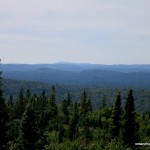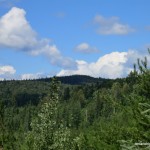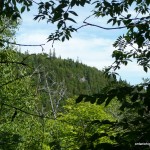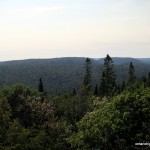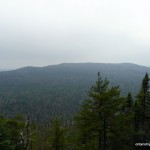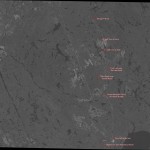Kwagama Hill
Posted by Derek on Oct 20, 2014
Rank: 17Height: 2106 feet / 642 m
GPS recorded height: 2099 feet / 640 meters
Lat/Lon: N47 24.882/W84 33.535
Line Parent: Blackspruce Lake Peak
Key Col: N47 36.949 W84 31.633 (1115ft / 340m)
Clean Prominence: 991ft / 302m
Date Summited: August 13, 2014
Overview:
Kwagama Hill is a mountain 6 km due west of the popular Algoma tourist attraction, the Agawa Canyon, which is serviced by the Agawa Canyon Train Tour from Sault Ste Marie. Even though the area is fairly popular for backcountry excursions, there are very few trips up to Kwagama Hill. There was a fire tower on the summit of the peak, however it was knocked down in a heavy ice storm in 1965. The twisted metal remains are still visible today. The summit of Kwagama Hill affords outstanding views west to Lake Superior. Read the rest of this entry »
Kwagama Hill – Winter Ascent
Posted by Derek on Apr 9, 2014
Rank: 17
Height: 2106 feet / 642 m
Lat/Lon: N47 24.882 W84 33.535
Line Parent: Blackspruce Lake Peak
Key Col: N47 36.949 W84 31.633 (1115ft / 340m)
Clean Prominence: 991ft / 302m
Overview:
Kwagama Hill is a mountain 6 km due west of the popular Algoma tourist attraction: The Agawa Canyon, which is serviced by the Agawa Canyon Train Tour out of Sault Ste Marie. The area is fairly popular for backcountry excursions and because of this, there occasional trips up Kwagama Hill. There was a fire tower on the summit of the peak, however it was knocked down in a wind storm many years ago. The twisted metal remains are still visible today. The summit of Kwagama Hill affords outstanding views including west to Lake Superior.
Read the rest of this entry »
Blackspruce Lake Peak
Posted by Derek on Aug 17, 2013
Rank: 10Height: 2146 feet / 654 m
GPS recorded height: 2148 feet / 655 meters
Lat/Lon: N47 37.012 W84 19.441
Line Parent: Ogidaki Mt
Key Col: N47 41.543 W84 01.056 (1411ft / 430m)
Clean Prominence: 735ft / 224m
Date Summited: August 8, 2013
Overview:
Blackspruce Lake Peak is a remote peak in the Algoma Wilderness, northeast of the Agawa Canyon. The mountain is the easternmost member of a group of peaks, which includes another 2100 footer; Parch Creek Peak East. Blackspruce Lake which gives the mountain it’s name, drains into Blackspruce Creek, which winds it’s way west into the Agawa River at the Algoma Central Railway.
Marne Peak
Posted by Derek on Aug 18, 2012
Rank: 17Height: 2106 feet / 642 m
GPS recorded height: 2135 feet / 651 meters
Lat/Lon: N46 57.374 W84 07.127
Line Parent: Ogidaki Mt
Key Col: N46 59.010 W84 01.024 (1640ft / 500m)
Clean Prominence: 466ft / 142m
Date Summited: August 3, 2012
Overview:
Located in the hills southwest of Ogidaki Mt., Marne Peak is the most southern 2100 footer peak in the Algoma Highlands. The peak has no official name and no significant nearby body of water so it has been named for the township in which it resides, Marne. The Algoma Central Railway passes within 8 km west of the peak at the Achigan and Ogidaki stations.
Directions::
From Sault Ste. Marie, take Highway 17 North and at the junction with Highway 556, turn East. Stay on 556 for 39 km and then turn left on Highway 532 north to Searchmont. Follow Highway 532 through the communities of Searchmont and Wabos for 14.3 km to the end of the road. Turn left onto the dirt road to Achigan Lake.
Stay on the main road to Achigan for 17.1 km where it joins up with the old Achigan road. (The old Achigan road is no longer a viable route from HW 532 as from this point back to HW 532 is no longer maintained, contains major washouts and crosses the ACR tracks illegally). Turn right at the intersection and proceed northwest towards Achigan Lake. At the 19.3 km, you pass by the old Achigan Station Section House which is now privately owned. At 21.3 km turn right as the the main road forks to the left. (The main road heads to the south end of Achigan Lake which is a access point for the boat access only camps on the lake.) The road beyond this turn is very rough and is not recommended for anything but high clearance 4×4 trucks and ATVs.
1.7 km beyond the south Achigan turnoff (23.2 km mark), the road to the north end of Achigan Lake forks to the left. Park just beyond this fork at a small clearing. The road beyond this point is rough and narrow and is only suitable for ATVs and dirt bikes.
Continue on foot or on bike along the ATV path for 1.5 km to where a beaver dam has flooded the entire area including the road. It is possible to avoid most of the flood zone by crossing along the top of the beaver dam. Beyond the beaver dam, continue north for 0.6 km to a hidden right turn onto an overgrown path. 1.8 km from the right turn, the ATV path ends at a creek and beaver pond. Cross the stream along the top of this much shorter beaver dam to a trail that is almost completely overgrown. If riding bikes, this is a good place to stash them.
The overgrown trail runs northeast, parallel to a small creek. After about 1.5 km from the beaver dam, the trail disappears entirely and the rest of the route to Marne Peak must be bushwhacked. It is recommended to continue bushwhacking northeast for 1.0 km until arriving at a large sloping rock outcrop. This is the site of an old logging chute which was used to flush logs down off the mountain.
From the old logging chute, head north and then northwest following the contours and then gradually ascending the notch towards the saddle between Marne Peak and it’s sub-peak to the south. As Marne is partially crowned by steep cliffs along it’s southwest side, head northwest along the base of the cliffs to where they taper off and the ascent is more gradual. Once reaching the top of the cliffs, head northeast towards the flat summit area. There are several candidate high points, however a small hill 70 meters south-southeast of the OBM spot point appears to be the highest. The summit is wooded and there are no views.
Note: It may be possible to access the peak from the north via a series of ATV / overgrown roads leading from Mile 38 Road and McDonald Creek Road, however this route has not been confirmed.
Read the rest of this entry »
Alvin Lake Peak
Posted by Derek on Aug 17, 2012
Rank: 15Height: 2116 feet / 645 m
GPS recorded height: 2125 feet / 648 meters
Lat/Lon: N47 14.728 W84 16.387
Line Parent: Ogidaki Mt
Key Col: N47 20.237 W83 59.589 (1345ft / 410m)
Clean Prominence: 771ft / 235m
Date Summited: August 2, 2012
Overview:
Located 8 km south of the Montreal River and 5 km west of Grey Owl Lake, Alvin Lake Peak is a 2116 foot hill residing in the remote Algoma Highland wilderness. Officially the peak is unnamed, but in keeping with naming conventions, it has been given the name of the closest significant body of water: Alvin Lake, which is 2 km north of the peak. Interestingly, Alvin Lake does not drain into nearby Montreal River, but in fact is in the Batchawana River watershed. The Algoma Central Railway near the old Rand station passes within 8 km of the summit.
Directions::
There is no trail to Alvin Lake Peak, however roads: Mile 38 and Mile 67/Mile 92 pass within 3.8 km and 2.8 km respectively of the summit. Since Mile 67 is much better maintained than Mile 38, this is the best approach to the mountain. The well maintained Mile 92 (Montreal River Power Dam Road) which follows the southern shoreline of the Montreal River Reservoir to Mackay Dam is another way to gain access the mountain as it connects with Mile 67 at kilometer 32, however the road is gated and requires a key.
Mile 67 Roads begins 36 km beyond Batchawana Bay on Highway 17 at N47 07.114 W84 41.915. The road crosses and forks many roads on it’s 46 km journey to the base of Alvin Lake Peak. (It’s highly recommended to make use of the attached GPS file when navigating this road). There are left turns at these major intersections: 6.2 km, 18.0 km, 26.9 km. At 32 km Mile 92 road connects in from the left. Keep right at this intersection and proceed to the Algoma Railway Crossing near Rand Station at 37.8 km. Beyond the railway crossing the road narrows and becomes rougher, but high clearance vehicles should be able to make it all the way to the start of the bushwhack near the road termination at 46.3 km (N47 13.383 W84 17.329).
Before the slopes of Alvin Lake Peak can be ascended, navigate a large marshland and creek which runs roughly parallel to Mile 67 Road. The easiest way to cross it is to head west from the road and walk along the top of a beaver dam located at N47 13.448 W84 17.026. Beyond the beaver dam, head northwest, gaining elevation and head towards an unnamed lake. A creek which flows southwest from the lake along an uncharacteristically steep chasm can be crossed via a beaver dam situated along the lake shore.
Follow the west edge of the lake until reaching the northern shore and then head north for 1.5 km though forest. Large white pines which survived logging dot the area. Just south of the Alvin Lake Peak summit area, a small pond must be circumvented. It is more direct to round the lake on the eastern edge to reach the more moderate south slopes up to the summit as the western side of Alvin Lake Peak is dominated by steep rock cliffs.
Once gaining the top of the last steep pitch, proceed northwest across the mostly open summit area though grass and exposed rock outcrops to the highest point on the mountain at N47 14.728 W84 16.387. On clear days, there should be good views west to Peak 637 atop the western cliffs.
Read the rest of this entry »
Spider Lakes Peak
Posted by Derek on Aug 9, 2012
aka. Brant Lake Peak (no official name)
Height: 2096 feet / 639 meters
GPS recorded height: 2109 feet / 643 meters
Lat/Lon: N47.05082 W84.56093
Date Summited: August 1, 2012
Overview:
Spider Lakes Peak is a high hill in the Algoma Region of Ontario. It is located 12 km north of the scenic tourist destination: Batchawana Bay, 1.5 km east of Brant Lake and less than 1.0 km west of a group of lakes named the Spider Lakes (thus named). A spot height recorded on the Ontario Base Maps determines the mountain to be a few feet short (2096 feet) of 2100 feet, however GPS measurements at the summit place it higher (2109 feet).
Directions:
Travel north from Sault Ste. Marie on Highway 17 to Batchawana Bay. Turn right on Carp Lake Road which is about 1.4 km beyond the Voyageur Lodge and Cookhouse which is located across the road from Batchawana Bay. Carp Lake Road is a gravel road, wide enough for 2 vehicles in most spots and is in good enough shape that high clearance 4×4 vehicles should be able to make the entire 14.3 km road portion of the trip. Cars and 2 wheel drive vehicles may have trouble making the 600 foot ascent up the road and should park at a gravel pit along side the road at 1.6 km.
4.0 km from Highway 17, the road becomes steep and ascends 500 feet (most of the ascent) over the next 2 km. Turn left at the 8.0 km mark and continue up the road, past the steep cliffs of Mamainse Hill until reaching a series of campsites along the Cedar/Brant Lakes.
Just past Brant Lake, 14.3 km from Highway 17, the road reaches its closest point to Spider Lakes Peak. Begin the 1.5 km / 800 foot ascent bushwhack here, heading on a 124 degree magnetic north course towards the summit. Although the ascent is unrelenting, the bushwhack is through fairly open deciduous forest. The summit area alternates between open lichen rock outcrops and thick tag alder bushes. There are limited views at the summit, southwest towards Mamainse Lake and east towards Griffin Lake Peak with it’s fire tower faintly visible.
Gong Lake Peak
Posted by Derek on Sep 24, 2011
Rank: 17
Height: 2106 feet / 642 m
GPS recorded height: 2132 feet / 650 meters
Lat/Lon: N47.04822 W83.62115
Line Parent: Witchdoctor Lake Peak
Key Col: N47 03.397 W83 42.148 (1624ft / 495m)
Clean Prominence: 482ft / 147m
Date Summited: August 15, 2011
Overview:
North of Ranger Lake in a remote corner of the Algoma highlands, Gong Lake Peak is one of three virtually unknown high points. It is thus named because of its close proximity to the lake bearing its name. There are no trails to the summit, however it can be hiked in a day by bushwhacking from one of the nearby logging roads in the area.
Directions:
Click here for directions from Sudbury to nearby Gravel Lake. From Gravel Lake, follow Domtar Road northeast for 5.5 km until reaching the junction with an ATV trail at N47.04537 W83.58467. Follow the ATV trail northwest for 800 meters at which time a second ATV trail enters from the right. Stay to the left at the fork and follow the trail for another 700 meters until it ends at a beaver dam at the east end of a lake. Cross the beaver dam and begin the bushwhack along the north edge of the lake. The bushwhacking will be difficult as a there is a steep hill running down into the lake and the bush on the hill is equally thick as along the flooded shoreline.
After bushwhacking 700 meters and reaching the northwest end of the lake, you must pass around a flooded lowland forest and cross a small creek. Beyond the creek crossing, the bushwhacking eases into more open forest and begins to ascend the remaining 1.1 km to the summit. A few rocky humps adorn the hardwood forested summit – the one at the northeastern edge of the highest contour is the highest point on the peak. The high point is treed, however there are good views to the north and east from a rocky ledge 30 meters to the east.
Read the rest of this entry »
Witchdoctor Lake Peak
Posted by Derek on Sep 24, 2011
Rank: 16
Height: 2113 feet / 644m
GPS recorded height: 2116 feet / 645 meters
Lat/Lon: N47.05528 W83.76377
Line Parent: Seal Lake Peak
Key Col: N47 02.049 W83 36.667 (1581ft / 482m)
Clean Prominence: 532ft / 162m
Date Summited: August 14, 2011
Overview:
North of Ranger Lake in a remote corner of the Algoma highlands, Witchdoctor Lake Peak is one of three virtually unknown high points. It is thus named because of its close proximity to the lake bearing its name. There are no trails to the summit, however it can be hiked in a day by bushwhacking from one of the nearby logging roads in the area.
Directions:
Click here for directions from Sudbury to nearby Gravel Lake. From Gravel Lake, follow Domtar Road west until reaching the junction with Laughing Lake Road, 1.8 km past Gravel Lake. Keep right on Domtar road which travels northwest along the shore of Tujak Lake. When the road veers right, 7.8 km from the junction with Laughing Lake road, park at the small pull off at the start of an ATV trail. From this parking area, it is a 3.0 km (as the crow flies) bushwhack westward – 256 degrees magnetic heading to the summit of Witchdoctor Lake Peak. The bushwhack begins steeply but then flattens out and passes through deciduous and then mixed forest. 1.3 km from the parking area, you will pass by the northern edge of a marsh which must be crossed. There is another marsh crossing 500 meters beyond, 1.8 km from the parking area. After the 2nd marsh, the route climbs slightly until reaching the partially open summit of Witchdoctor Peak, 3.0 km. The highest point is atop a moss covered bald rocky ledge. There are partial views to the west about 50 meters west of the summit.
Read the rest of this entry »
Seal Lake Peak
Posted by Derek on Sep 4, 2011
Rank: 14
Height: 2119 feet / 646 m
GPS recorded height: 2125 feet / 648 meters
Lat/Lon: N46.99489 W83.63967
Line Parent: Ogidaki Mt
Key Col: N47 07.470 W83 54.824 (1440ft / 439m)
Clean Prominence: 679ft / 207m
Date Summited: August 13, 2011
Overview:
North of Ranger Lake in a remote corner of the Algoma highlands, Seal Lake Peak is one of three virtually unknown high points. It is thus named because of its close proximity to the lake bearing its name. There are no trails to the summit, however as there are roads and ATV trails in the area, it can be hiked in a day by bushwhacking from the closest trail approach.
Directions:
From the Sudbury region, make your way west along Highway 17. At Iron Bridge, turn right (north) onto 546 and follow it for 27 km until turning left (west) onto 554 for another 27 km. When the 554 ends at 129, turn right and follow Highway 129 north for 66 km to the turnoff to Ranger Lake at 556. Highway 556 is a gravel road which winds its way west to Ranger Lake, eventually ending at Highway 17 at Lake Superior. At the 12.5 km mark along 556, the Domtar Road will branch to the right. This is one way access the region around Seal Lake Peak, however just past Ranger Lake at the 34.6 km mark, the better maintained Laughing Lake Road branches to the right and makes it’s way north to the same area. Follow Laughing Lake Road north for 25 km until it ends at the Domtar Road. Turn right (east) onto Domtar road. There is a good campsite on Gravel Lake, just 1.8 km east of the intersection. There are another 2 campsites in the area, one of which lies in an old gravel pit at the east edge of the lake.
From these campsites, it is just a short hike along the Domtar Road to the start of the ATV trail at N47 01.412 W83 37.904, which leads to Seal Lake Peak. Follow the ATV trail south to Saw Lake which will require a water crossing as the trail has been flooded by the beaver dam / raised water levels. It is possible to avoid the water crossing, by skirting it along the western shore of the flooded lake. Rejoin the ATV trail and proceed south, passing 2 other lakes en route until arriving at a 4th lake, 3.2 km from Domtar road. Here the ATV trail ends and the remainder of the 1.0 km distance to Seal Lake Peak must be bushwhacked. Bushwhack up the gradually ascending slopes until reaching the hardwood forest near the summit. After crossing a fern covered glen, the highest point can be reached by ascending a moderately steep hump at the southern edge of the highest contour. A clearing atop a moss covered rocky area marks the highest point.
Ishpatina Ridge (Tower Summit) – Overland
Posted by Derek on Sep 5, 2010
Rank: 1
Height: 2275 feet / 693 m
GPS recorded height: 2298 feet / 700 m
Lat/Lon: N47 19.002, W80 44.930
Key Col: N49 32.433 W85 35.183 (981ft / 299m)
Clean Prominence: 1293ft / 394m
Summited on (Overland Route): August 1, 2010
Overview:
The Ishpatina Ridge, set in a remote corner of the Lady Evelyn-Smoothwater wilderness park, is a series of worn and rounded bumps spanning approximately 13 km. The Ellis Fire Tower, a lonely sentry and reminder of days of old, sits on the tallest of the bumps and looks out across the vast expanse of Canadian Shield wilderness. At a height of 2275 feet / 693 m, the Ishpatina Ridge is the highest point in Ontario. From a logging road crossing at the Sturgeon River, the Ishpatina Ridge can be climbed in a day by following a series of logging roads, overgrown bush roads, hiking trails and bushwhacks.
Directions:
There are 2 routes to the Ishpatina Ridge:
- The traditional and most common route begins as a multi-day canoe trip up the Montreal River, over a series of lakes and portages between Smoothwater Lake and Scarecrow Lake and ends with a hike up to the summit via an old fire tower watchman’s trail.
- More recently, many hikers have begun to use an overland route accessed via a series of logging roads which are accessed north of Capreol (near Sudbury). Most hikers begin on foot or by bike at a rugged road crossing of the Sturgeon River and follow the road north to a series of overgrown bush trails. Combined with a bushwhack along the west shore of Scarecrow Lake and the usual fire tower trail hike from the trailhead on Scarecrow Lake, many hikers are able to complete the trip from car to car in a long day hike.
Click here for my trip report to Ishpatina Ridge via the Montreal River (traditional canoe route)
Directions to the Ishpatina Ridge via the overland route is as follows:
From the Sudbury area, make your way to Garson either via the Falconbridge Highway (RR-86) or the Garson/Coniston Road (RR-90). Take RR-85 for 18.4 km to Hanmer, and after it jogs across the train tracks follow RR-84 to Capreol which is 6.5 km ahead. Passing through the small town of Capreol, continue along the road for another 8.0 km and then turn right onto Portelance Road. It is 64.4 km from the intersection at Portelance Road to the Sturgeon River, so it would be advisable to make sure you have proper provisions before making the trip. Also, the road may have active logging in progress, so caution is advised — give the logging trucks a lot of space.
The first 5 km of the dirt road is fairly wide and well traveled by the residents of the Wahnapitae First Nation Reserve. The road forks at the Wahnapitae First Nation Reserve sign. Take the left fork and proceed along the road which runs in a north-northeast direction for 15.5 km until meeting up with the Wanapitei River. Do not cross the River at the bridge here, but continue along the west shoreline of the River for another 5.3 km. 20.8 km from the turnoff at the Wahnapitae Reserve, the road crosses the Wanapitei River and follows the eastern shore of the river for another 8.8 km until Stobie Road forks to the right. Cars with low ground clearance will have to be cautious as sometimes the gravel can pile up in the center of the road. Turn right (east) onto Stobie Road and follow the road eastward.
After 5.7 km, the Gervais Road which travels 24 km to the south shore of the Sturgeon River, branches to the left. Following the Gervais Road north, turn left at the forks at 9.2 km and 14.1 km from the intersection with Stobie Road. The final 15 km of road, although quite rough, are still passable for cars as long as caution and common sense are used — drivers should be prepared to drive 20-30 km/h. The Google satellite imagery for the northern half of the Gervais Road is not up to date (as of September 23, 2011) — please see the attached satellite imagery from geobase.ca to see the new extension to Gervais Road.Just before reaching the Sturgeon River, there is a large flat area (old gravel pit) which can easily handle group camping. There is also a smaller campsite right at the river. If camping within 120 meters of the Sturgeon River, a back country pass will be required.
In most situations it should be possible to wade across the Sturgeon River, however strong currents in combination with high water levels can make the crossing hazardous. After crossing the Sturgeon River, stay on the main gravel road north. This road can easily be biked, and if attempting to hike the Ishpatina Ridge and back in a single day, it is recommended to bring a mountain bike for this section.
5.1 km from the Sturgeon, the road fords a small stream which connects Little Scarecrow Lake and Hamlow Lake. However, there is a small makeshift log bridge just east of the road, which crosses the stream. The road skirts the eastern shore of Stull Lake and 1.4 km from the makeshift bridge, an overgrown bush road branches to the right. If on a bike, stash the bike near the intersection here and follow the overgrown bush trail on foot.
Follow the bush path north for about 290 meters and turn east on another bush path which branches to the right. Follow this path eastwards for 570 meters until reaching another fork — take the left fork. The trail past the fork, although marked with flagging tape and blazes, quickly becomes overgrown and passes through some marshy areas. Initially the overgrown trail travels east, but after 0.5 km, the trail turns north. After another 0.5 km, the trail swings right (east) and continues for 0.5 km until terminating. The remaining distance to the Ishpatina trail trailhead on Scarecrow Lake must be bushwhacked. The Ishpatina Ridge Trail trailhead lies 2.5 km (as the crow flies) away from this point. From the end of the bush trail, bushwhack 85 degrees (magnetic north) for 900 meters to the shore of Scarecrow Lake — stay along the southern edge of the hills along the route, as there is no need to climb them. Note: As of September, 2010, the trail has been extended for 1 km to Scarecrow Lake and along the west shore of the lake, cutting the bushwhack to 1.5 km.
If water levels are low on Scarecrow Lake, it may be possible to save time and energy by walking along the rocky shoreline. Occasionally, one will have to swing back into the bush to avoid blow-down and/or marshy areas. There is also a a fairly well established animal path along the lake edge. Once reaching the northwest shore of Scarecrow lake, the bushwhack ends at a well-established campsite and the start trail to the Ishpatina.
The 3.7 km trail to the Ishpatina Ridge – Tower Peak begins at the canoe launch on Scarecrow Lake and ascends through an area regenerating from a recent bush fire — wild raspberries and blueberries are abundant here. The trail skirts a small lake and begins a moderate ascent northwards. About 1.7 km from Scarecrow Lake, the trail passes through a lowland marsh near a second lake along the trail. Logs and wood planks have been layed along the trail to make the passage across easier. Once traversing the marsh, the trail begins to climb more steeply for 0.7 km.
2.4 km from Scarecrow Lake, the trail gains the top of a ridge. This would be the most advantageous place to start the bushwhack to Ishpatina’s South Peak. The trail then descends slightly to Dick Lake, the third and final lake on the route to the summit.
Crossing an overgrown beaver dam at the east edge of Dick Lake, the remaining 1.1 km of trail ascends almost 500 feet to the summit. Closer to the top, the firetower at the summit will come into view. A large boulder hidden by thick bushes at N47.31670 W80.74884, 50 meters from the base of the tower may be the highest point on the summit. At the base of the tower, there are good views towards the North and South peaks.
*Last update: September 23, 2011.
Trip Summary:
00.0 km – Turn onto Portelance Road from RR-84
05.0 km – Turn left at the fork at the Wahnapitae First Nation Reserve sign
20.7 km – Road reaches Wanapitei River, stay on the west shore of the river
25.8 km – Road crosses the Wanapitei River at Fraleck Bridge. Road continues along east shoreline
34.6 km – Turn right onto Stobie Road
40.3 km – Turn left onto Gervais Road
49.5 km – Turn left at the fork
54.4 km – Turn left at the fork
64.4 km – Gravel pit camp near Sturgeon River
00.0 km – Ford Sturgeon River and hike/bike along gravel road
06.7 km – Turn onto overgrown bush road
07.0 km – Turn right onto bush road #2
07.5 km – Take left fork onto overgrown trail
09.0 km – End of the trail, beginning of the bushwhack to Scarecrow Lake
10.1 km – Scarecrow Lake – hike along shoreline to Ishpatina Trailhead
12.3 km – End of bushwhack, beginning of the Ishpatina trail
15.0 km – Ishpatina Ridge – Tower Peak
